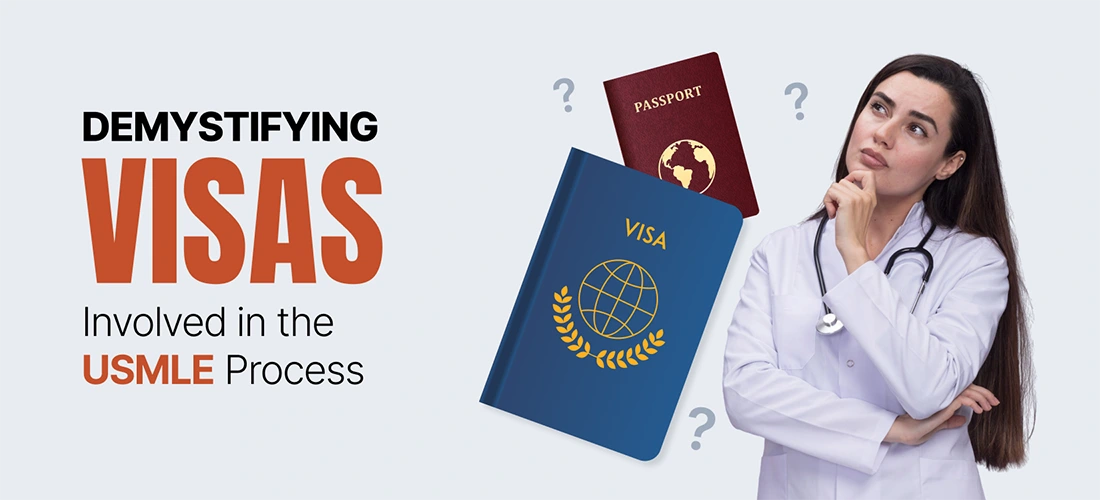
Editor’s note (Sept 23, 2025): H-1B fee update - For new H-1B petitions submitted on or after September 21, 2025, the White House has imposed a $100,000 fee. Current guidance indicates existing H-1B holders are not charged this fee, and physicians may qualify for exemptions that the administration is considering in the national interest. We summarize what this means for IMGs in the H-1B sections below.
If you're a medical graduate looking to pursue further training or residency in the United States, understanding the visa options available is crucial. The right visa can significantly impact your career path. Let's break down the categories of visa for the USMLE (United States Medical Licensing Examination) process and their key features. Getting a visa for the USMLE is a crucial part to understand.
Recent changes to H-1B costs (see Editor's note) are primarily about new petitions, and health-care exemptions are being discussed, so IMGs should track updates closely. With the help of this blog, you get enlightened on the important aspects of the visa for USMLE.
Categories of Visa Involved in the USMLE Process
To get a visa for medical residency in the USA, it is very important to understand the different categories that are involved.
- B-1/B-2 Visa (USCE): This visa is used for clinical experiences like USA Clinical Experience (USCE) by medical students, known as a tourist visa. A visa for clinical rotations in the USA under B-1/ B-2 is valid for six months.
- J-1 Visa (Residency/Fellowship/Research): The J-1 visa is a work visa commonly used for medical residency, fellowships, or research programs.
- H-1B Visa (Residency/Fellowship/Research): A work visa is sometimes used for residency/fellowship/research, typically requiring USMLE Step 3 completion before starting. The U.S. has declared a $100,000 fee for new H-1B petitions filed on/after Sept 21, 2025. The present H-1B holders are not charged, and the White House has signaled potential exemptions for physicians in the national interest. Always confirm with your program's GME/HR and your immigration counsel.
- F-1 Visa (Academic Programs): If you're studying to pursue academic programs like MPH (Master of Public Health), MHA (Master of Health Administration), or research, the F-1 visa is suitable.
By understanding all the categories, you can easily choose a visa for medical residency. It is important to remember that for residency, you get a salary, but if you are studying for a student visa or clinical rotations, you have to pay tuition fees to the university.
Foreign National Physicians in US GME
Understanding the background of foreign national physicians in US Graduate Medical Education (GME) is essential. There are different paths for international medical graduates, US graduates, and Canadian graduates, each with its own requirements and considerations.
International Medical Graduates
Need an ECFMG (Educational Commission for Foreign Medical Graduates) Certificate.
Must meet specific visa and visa status requirements.
US Graduates
Have US diplomas and may have completed USMLE or COMLEX exams.
Must consider their visa and visa status.
Canadian Graduates
May have Canadian diplomas and could have completed USMLE exams.
Visa and visa status are important factors.
Most Common USMLE Visa Options for GME: J1, H1-B, J2 with Employment Authorization (EAD).
ECFMG is the primary sponsor of J-1 Physicians, and both J-1 and H1-B visas have distinct characteristics.
Basic Differences in J-1 and H1-B Visas
| Features |
J-1 Visa |
H-1B |
| Features |
Exchange Visitor Physician |
Speciality Occupation Worker |
| Funding Source |
Multiple: ECFMG |
Unique: US Employer (Such as a residency program) |
| Department of State & Department of Homeland Security |
| Requirements |
ECFMG Certification |
ECFMG Certification |
| USMLE |
USMLE step 1, step 2 CK |
USMLE step 1, Step 2 CK, Step 3 |
| Visa Type |
Exchange visa - Non-immigrant (Temporary visitors) |
Employment visa – Non-immigrant (Temporary visitors) |
| Time Limit |
Seven years maximum |
Six years maximum |
| Funding |
Generally, Hospital salary or home government/ other |
US employer salary only |
| Fees |
ECFMG –$160 |
$100,000, often paid by the employer |
| SEVIS – $220 |
| J-1 Visa – $370 |
| Total - $750 Approx. |
| Processing time |
1-2,5 months approximately |
3-5 months (can be faster with premium processing) |
| Strong ties to Home Country required? |
Yes |
No |
| Mandatory return to Home Country after Residency? |
Yes, with a two-year return requirement, but it can be waived |
No Requirement |
| Spouse and family visa |
Dependents can get J-2 Visas; Spouses can work |
Dependents can get H-4 Visas; Spouse can’t work |
| Dual Intent (Can the visa holder pursue permanent residency, like a Green Card?) |
No. After completing the program, applicants must go back to their home country for two years or obtain a waiver for three years. Afterwards, they can apply for a job on an H1B visa and then start the process of obtaining a Green Card through their employer. |
Yes, Allow |
J-1 Visa
The J-1 visa is a good choice for students and professionals who want to come to the United States.
It has many benefits. The application is often simpler and less expensive than other visas.
A major plus is that the husband or wife of a J-1 visa holder can also work in the U.S. They just need to get a work permit. This helps families earn two incomes.
The J-1 visa is also accepted by many programs, including special training fellowships. This opens doors for career growth.
For doctors from other countries, the J-1 visa is a common path. It allows them to complete their medical residency in the United States. Getting this visa is a big step toward their dream of practicing medicine here.
Earning a J1 visa USMLE pathway is a significant achievement for international medical graduates pursuing their dreams of practising medicine in the United States.
H1-B Visa
The H-1B visa can be a good option for doctors from other countries.
It has some key benefits. It lets you work toward a green card right away. You do not have to return to your home country after your training. It can also lead to more job choices after your residency or fellowship.
But there are also some drawbacks. The application costs are higher. Your spouse may not be able to get a work permit. Also, not all residency or fellowship programs offer this type of visa.
For these reasons, the H-1B visa can be a great choice for some doctors. But it is very important to think about both the good and bad points before you decide.
Latest News for International Doctors (September 2025)
Here is what you need to know about a new rule for the H-1B visa.
- New Fee: A new $100,000 fee starts on September 21, 2025. It only applies to people applying for a new H-1B visa on or after that date. If you already have an H-1B visa, this new fee does not affect you.
- Good News for Doctors: The White House has said that doctors might not have to pay this fee. They recognize that the country needs more doctors. We are still waiting for the final rules on this exemption.
- What This Means for You: Some hospitals might now think twice about sponsoring H-1B visas because of the high cost. They may choose the J-1 visa instead. Your chances of getting an H-1B could depend on your medical specialty and the hospital you apply to.
What You Should Do
- Ask the hospital's training office (GME) about their visa plans.
- Make sure you know when to take your USMLE Step 3 exam.
- Think about other options for backup. For instance, under a unique scheme, you could begin with a J-1 visa and eventually change to an H-1B.
An H-1B visa offers a clearer path to staying in the U.S. permanently. Because of this, many doctors look for residency programs that sponsor this visa. However, getting an H-1B visa can be much harder if you have not passed the USMLE Step 3 exam.
Your long-term goals will determine which visa is best for you. If you want to stay in the U.S. and maybe do a fellowship, you need a good plan for your exams and your visa from the very beginning.
It is easier to get a fellowship on a J-1 visa. Only 10% of medical aspirants get a fellowship on an H-1B visa, and preference can be either. But fellowship chances are high on a J-1 visa. Academic research positions are also easily available on a J-1 visa. You don't have to apply for any preferences, but you get them once you get the match.
All medical aspirants would have B1/ B2 tourist visas. Having a B1 visa for clinical rotations in the USA is very important and necessary.
The Visa medical residency in the USA is significant to understand because there might be USMLE visa issues. Different things can happen when you're applying for residency. So it's crucial to choose the right visa option.
Consider two main factors: Whether you want to become a permanent US resident. And whether you plan to do a fellowship after residency.
Permanent Resident Status
This visa is usually good for three years. You can often extend it for another three years.
You need to plan ahead if you want to do a fellowship. If your fellowship training will last more than three years, your visa timing could be a problem. One solution is to start the process for a green card during your residency. This can make applying for fellowships much easier.
Remember, choosing the right visa is a very important step. You need to have the correct visa to take the USMLE Step 3 exam. This exam is required for you to practice medicine on your own in the United States.
Thinking About a Fellowship?
Both J-1 and H-1B visas let you start a fellowship after you finish your residency. But they work differently.
The J-1 Visa for Fellowships
- This is a very common choice for fellowship programs.
- It has a rule called the "two-year home residency requirement." This means you must return to your home country for two years after your training.
- The good news is, you can do your fellowship first, and then fulfill this requirement.
- You can also apply for a "waiver" to skip this rule. One way is to work in an area that needs more doctors. If you get a waiver, you can then apply for an H-1B visa and a green card.
The H-1B Visa for Fellowships
- This visa is less common for fellowships.
- Its biggest advantage is that it is a direct path to a green card. There is no two-year home requirement.
In Simple Terms:
- Choose an H-1B visa if your main goal is to live in the U.S. permanently. It is best to stay after residency or a short fellowship.
- Choose a J-1 visa if you want more choices for your fellowship program. It is a great option for training, but it takes longer to get a green card.
Remember: The two-year home rule for the J-1 visa has solutions. Programs like Conrad 30 allow you to stay if you work in underserved communities.
Making Your Visa Choice
Choosing between an H-1B and a J-1 visa for your residency is a big decision. It can feel complicated. Remember, sometimes the program you match with will decide for you.
Here is what is most important for you to know right now:
Key Points to Remember
- USMLE Step 3: If you want an H-1B visa, you must pass the USMLE Step 3 exam before Match Day. This is a firm rule.
- New Fee (Sept 2025): A new $100,000 fee for H-1B visas might make some programs prefer the J-1 visa. There may be an exception for doctors, but you must ask each program about its policy before you finalize your rank list.
- Your Goals Matter: There is no single "best" visa. The right choice depends on you.
- Think about the H-1B visa if your main goal is to stay in the U.S. permanently.
- Think about the J-1 visa if you plan to do a fellowship, as it is more widely accepted.
How to Decide
When you make your Rank Order List, think about your long-term dreams. Do you see yourself living in the U.S. permanently? How important is a fellowship to you? Your choice should fit your own personal plan.
For more information, you can attend MOKSH live webinars and have personalized counselling sessions to help you decide. If you have further questions, feel free to email us or call our team.



